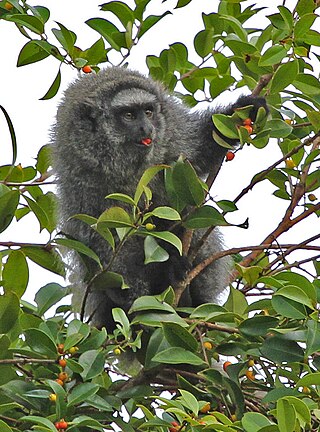
The coastal black-handed titi monkey is a species of titi, a type of New World monkey, endemic to Brazil.
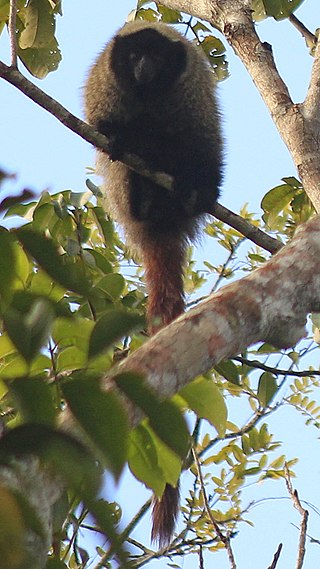
Coimbra Filho's titi monkey or just Coimbra's titi is a species of titi, a type of New World monkey, endemic to forests in the Brazilian states of Bahia and Sergipe. It was first discovered by Shuji Kobayashi. It is considered one of the most endangered of all Neotropical primates. It is named after Adelmar F. Coimbra-Filho, founder and Former Director of the Rio de Janeiro Primate Centre, in honor of his work in the field of Brazilian primatology and biology.

Prince Bernhard's titi monkey, also called the zog-zog monkey, is a species of titi monkey in the genus Plecturocebus, first described in 2002. It is named after Prince Bernhard of the Netherlands. They have varying coloration of gray, black, and agouti, with dark orange in certain regions. They are endemic to Brazil, found mostly in disturbed forest environments. While officially listed as least-concern by the International Union for the Conservation of Nature (IUCN), they may, in fact, be at-risk due to human-caused deforestation.

Mantella are a prominent genus of aposematic frogs in the family Mantellidae, endemic to the island of Madagascar. Members of Mantella are diurnal and terrestrial, with bright aposematic coloration or cryptic markings.

The golden mantella is a small, terrestrial frog endemic to Madagascar. It has an extremely restricted distribution in three distinct areas centered on the town of Moramanga - Beparasy and Ambohibary Communes, Torotorofotsy Wetland northwest of Andasibe, and in the area of Ambakoana. Mantella aurantiaca is one of Madagascar's most threatened amphibian species due to its limited distribution in an area under tremendous anthropogenic pressure. It may also be threatened by over-collection for the pet trade.
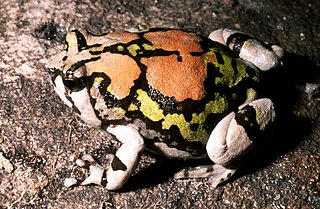
Scaphiophryne gottlebei, commonly known as the Malagasy rainbow frog, ornate hopper, rainbow burrowing frog, red rain frog or Gottlebe's narrow-mouthed frog, is one of the most highly decorated frogs from Madagascar. The primary threats to this endangered species are habitat loss and capture for the pet trade.

Mantella baroni is a species of small poisonous frog in the family Mantellidae.

The brown mantella is a species of frog in the family Mantellidae. It is endemic to Madagascar. Its natural habitats are subtropical or tropical dry forests, dry savanna, moist savanna, subtropical or tropical dry shrubland, rivers, freshwater marshes, intermittent freshwater marshes, rural gardens, heavily degraded former forest, ponds, and canals and ditches. It is threatened by habitat loss.

The Cowan's mantella is a species of frog in the family Mantellidae. It is endemic to Madagascar. Its natural habitats are subtropical or tropical moist montane forests, subtropical or tropical high-altitude grassland, and rivers. It is threatened by habitat loss. Collection for the pet trade has also been a threat.
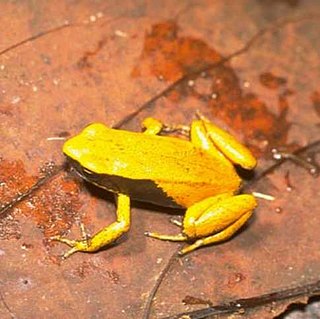
The yellow mantella or eastern mantella is a species of frog in the family Mantellidae. It is endemic to Madagascar. Its natural habitats are subtropical or tropical moist lowland forests, subtropical or tropical swamps, and swamps. It is threatened by habitat loss. Commercial collection may also be a threat.
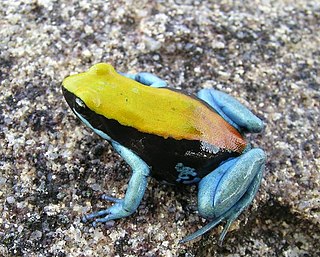
The blue-legged mantella is a small species of frog in the family Mantellidae. It is endemic to the Isalo National Park and areas south of it in Madagascar, a range it shares with the rainbow frog. Both are locally common, but endangered due to habitat loss and over-collected for the pet trade.

The Haraldmeier's mantella is a species of frog in the family Mantellidae. It is endemic to Madagascar. Its natural habitats are subtropical or tropical moist lowland forests and rivers. It is threatened by habitat loss.

The climbing mantella is a species of diurnal poison frog of the genus Mantella that resides in the subtropical regions of northeast Madagascar. Although it spends a significant amount of time in trees or bamboo forests, this frog species is not fully terrestrial and actively seeks areas with a water source.

Mantella madagascariensis, common names Malagasy painted mantella, Madagascan mantella, Madagascar golden frog, Malagasy mantella and painted mantella, is a species of frog in the family Mantellidae.
The Marojejy mantella is a species of frog in the family Mantellidae. It is endemic to Madagascar. Its natural habitats are subtropical or tropical moist lowland forests, rivers, swamps, and intermittent freshwater marshes. It is threatened by habitat loss.
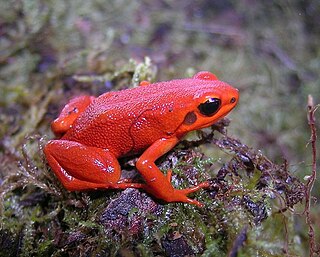
The black-eared mantella is a species of frog in the family Mantellidae. It is endemic to Madagascar. Its natural habitats are subtropical or tropical moist lowland forests, subtropical or tropical swamps, subtropical or tropical moist montane forests, and swamps. It is threatened by habitat loss. None of its habitat is currently protected (2017).

The Guibé's Mantella is a species of frog in the family Mantellidae. It is endemic to Madagascar. Its natural habitats are subtropical or tropical moist lowland forests and rivers. It is threatened by habitat loss.

The beautiful mantella, Parker's mantella, or splendid mantella is a species of frogs in the family Mantellidae.
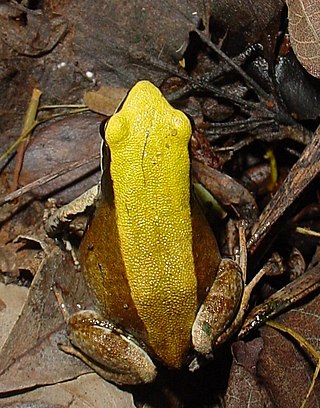
The green mantella is a species of frog in the family Mantellidae. It is endemic to Madagascar. Its natural habitats are subtropical or tropical dry forests, rivers, intermittent rivers, and heavily degraded former forest. It is threatened by habitat loss. The commercial trade in these species requires tight regulation in order not to threaten it.

Mantella ebenaui is a species of frog in the family Mantellidae. It is endemic to northern Madagascar with one of the largest ranges of any Mantella. Its natural habitats are rainforest and dry forests. Mantella ebenaui lay their eggs on land near the water. These eggs hatch into larvae which develop in small ponds before reaching maturity.




















